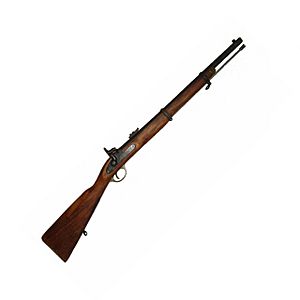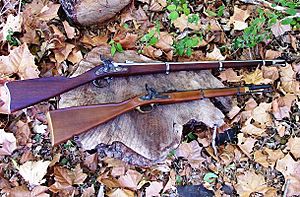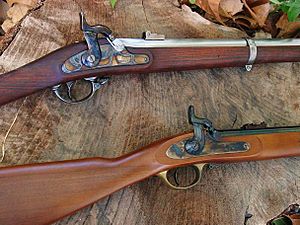Pattern 1861 Enfield musketoon facts for kids
Quick facts for kids Pattern 1861 Enfield |
|
|---|---|

Replica of a Pattern 1861 Enfield musketoon
|
|
| Type | Musketoon |
| Place of origin | United Kingdom |
| Service history | |
| In service | 1861-1889 |
| Used by | United Kingdom, United States, Confederate States, Empire of Japan |
| Wars | American Civil War, Boshin War |
| Production history | |
| Designed | 1861 |
| Manufacturer | Royal Small Arms Factory |
| Produced | 1861–1864 |
| Specifications | |
| Barrel length | 24 in (610 mm) |
|
|
|
| Cartridge | .577 ball |
| Caliber | .577 |
| Action | Percussion lock |
| Feed system | Muzzle-loaded |
The Pattern 1861 Enfield was a special type of short rifle called a musketoon. It was made in the United Kingdom in 1861. This weapon was a shorter version of the larger Pattern 1853 Enfield rifle.
It had a barrel that was about 610 mm (24 inches) long. Even though it was shorter, it was very accurate for its size. This was because it had a faster "rifling twist" inside the barrel. Rifling is the spiral grooves inside a gun barrel that make the bullet spin. This spin helps the bullet fly straight. The Pattern 1861 had five grooves, which was more than the three grooves in the longer Pattern 1853. This design made it easier to carry and reload, especially in tight spaces or on horseback.
Contents
What Was the Pattern 1861 Enfield?
The Pattern 1861 Enfield was a type of carbine. A carbine is a shorter, lighter version of a rifle. It was designed to be easier to handle than a full-sized rifle.
Key Features of the Pattern 1861
- Shorter Barrel: Its 24-inch barrel made it more compact.
- Improved Rifling: It had five spiral grooves inside the barrel. This helped the bullet spin faster and fly more accurately over shorter distances.
- Easy to Handle: Because it was shorter and lighter, it was easier for soldiers to carry and use, especially when moving quickly.
Who Used the Pattern 1861 Enfield?
This musketoon was used by different armies around the world. It was a popular weapon during the mid-1800s.
Use by the British Army
In the British Army, the Pattern 1861 was given to artillery units. Artillery soldiers operate large cannons, and they needed a weapon that was easy to use for their own protection. It was also good for soldiers who fought on horseback, like cavalry, because it was less bulky.
Use in the American Civil War
During the American Civil War (1861-1865), many of these weapons were bought by the Confederacy. They also gave them to their artillery and cavalry units. Soldiers liked how easy it was to handle. It could shoot special bullets called Minié balls, which were very effective up to about 500 yards (about 457 meters).
Why Not for All Soldiers?
While great for some, the longer Pattern 1853 rifle was usually better for infantry soldiers. These soldiers often fought in long lines. A longer rifle helped prevent accidents, like soldiers in the back accidentally shooting those in front.
Common Misunderstandings
Sometimes, this weapon is incorrectly called a "musketoon." However, because it has a rifled barrel (grooves inside), it is more accurately called a carbine. A musket usually has a smooth barrel without these grooves. Another similar weapon, the Enfield Pattern 58 'short rifle', is almost a foot longer than the Pattern 1861.
See also
- Pattern 1853 Enfield, a longer rifle musket with a similar design.
- British military rifles
- Rifles in the American Civil War



